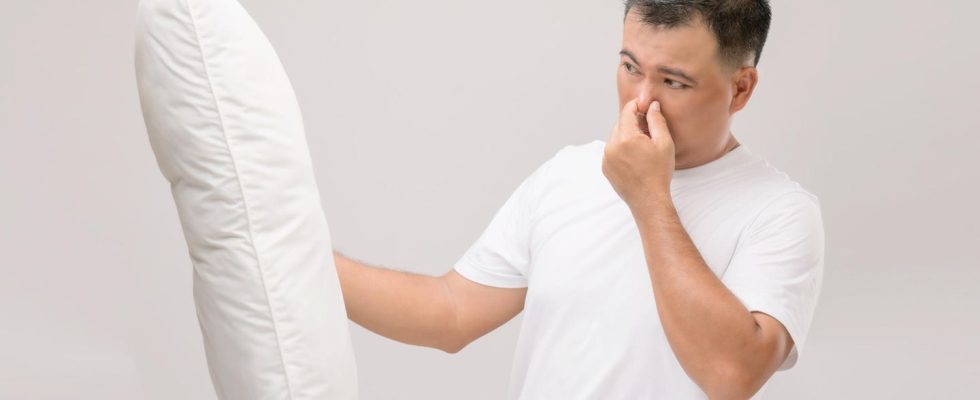Sweat, grease & dirt
How do you actually clean down? Hygiene tips for pillows and duvets
Down pillows should also be cleaned regularly for hygiene reasons
© PhanuwatNandee / Getty Images
Due to its warming properties, down is a popular filler. They are sewn into pillows, duvets or even winter jackets and ensure a pleasant temperature balance. But can they still be cleaned properly – and is this step necessary?
Table of contents
By fluffing up the feathers, fresh air gets into the inside of duvets and pillows so that night sweats can dry out. This means: The more often you loosen the textiles (preferably daily), the less often they need to be washed. Nevertheless, it cannot be avoided that sweat and dirt residues as well as house dust mites and their remains have a certain influence on hygiene in the long term. Or rather: your bed is starting to smell. For this reason, you should wash your down comforters and pillows regularly. We have summarized the steps you should definitely follow below for you.
And one more tip in advance: When purchasing down comforters or pillows, look for specific ones Certificationswhich provide information about the fact that the manufacturers of the textiles do not use live plucking or the use of stuffed geese.
Washing down: How to clean pillows and blankets
Pillow
Did you know that down pillows don’t have to be made entirely of down to be called such? In fact, it is enough if 60 percent of the content is down. Regardless of how high the proportion is, the hygiene of each pillow decreases with regular use. Body sweat and grease (via the scalp) leave visible residue on the cover, but dirt particles and dust mites also collect between the feathers. For this reason, it is recommended to have down pillows at least once a year to be cleaned – but not with ordinary detergent.
The fact is: Down contains keratin, a type of fibrous protein. However, commercial detergents that you normally use contain protease – this is an enzyme that dissolves protein-based dirt. In other words: In order to protect the feathers, it is important to use an enzyme-free one Down detergent to use. And only a third of the amount that you normally put in the washing machine. Otherwise the feathers would clump together. And that’s not all you should consider before cleaning:
- Before you put a down-filled pillow or comforter in the washing machine, you should all Seams check and the textiles for possible holes investigate. If you find what you are looking for, you should first grab a needle and thread so that the feathers are not suddenly removed from the textiles during cleaning.
- Depending on how big your washing machine is, you can wash two pillows at the same time. Are you not sure how much? volume the drum can hold, it’s better to play it safe and only clean one down pillow – the less space there is, the more the feathers are compressed.
- On the label The manufacturer notes how hot you can wash a pillow. For thorough cleaning that kills all bacteria, 60 degrees is recommended. But 30 degrees is also enough to clean the down. In any case, it is important that you choose a gentle wash cycle with a low spin speed.
A notice: Due to the low spin speed, down pillows or blankets are still very wet after washing. Here it can help to repeat the spin cycle again (with a few revolutions).
Duvets
By fluffing up the feathers every day, duvets filled with down have a kind of self-cleaning effect. Nevertheless, they should at the latest every two years washed to improve hygiene – especially that of the cover. However, it is important for you to know that the blanket can only be cleaned in a home washing machine (with a volume of five to 7.5 kilograms) if its capacity does not exceed 400 grams. Otherwise, it is advisable to visit a laundromat that has extra-large washing machines. Here too there should be a special one Down detergent be used. When cleaning yourself, proceed in the same way as you would with a down pillow (see a paragraph above).
How to properly dry down pillows and blankets
If you have a dryer, you can dry the down pillows or blankets in it after washing. Here too, it is important to take the volume of the drum into account and choose a gentle program that treats the textiles at low temperatures. To ensure that no residual moisture remains and promotes mold formation, you should repeat the process in the dryer several times in a row (three to four cycles of 20 minutes each).
Alternatively, you can air dry the pillows and blankets, but this takes significantly longer – i.e. several days. Don’t be fooled by a dry cover that doesn’t provide any information about the remaining moisture in the feathers. Therefore, do not hang up the textiles, but rather place them over a drying rack so that the down dries better and does not clump together. You should also shake pillows and blankets regularly. The more often, the better.
And one more tip at the end: Since the feathers stick together a lot after cleaning, it can be helpful to use special ones Dryer balls to use – they are supposed to loosen up the down.
Source: Utopia
You might also be interested in:
This article contains so-called affiliate links. Further information are available here.


